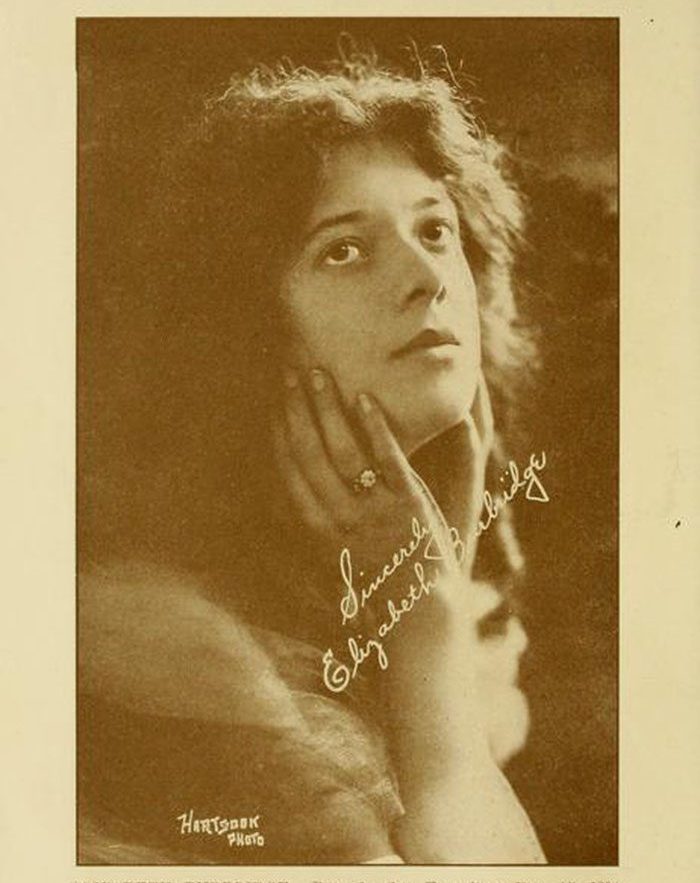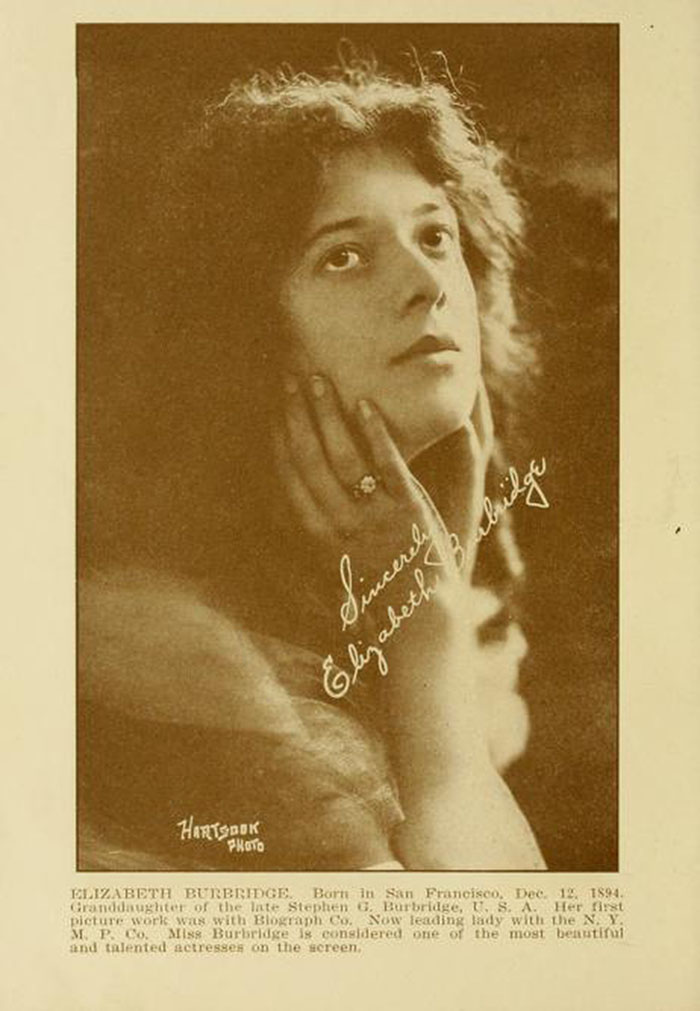In 1941, publications like Life and The Saturday Evening Post featured an advertisement for Smith-Corona typewriters. Presenting an image of screenwriter Betty Burbridge at work, the advertisement described her as “Gene Autry’s script writer,” having “typed her way to the top” (117). Although she did, indeed, work with Autry on many films for Republic Pictures during the 1930s and 1940s, becoming a prominent screenwriter for B-movie Westerns in particular, Burbridge’s career in Hollywood started long before that.
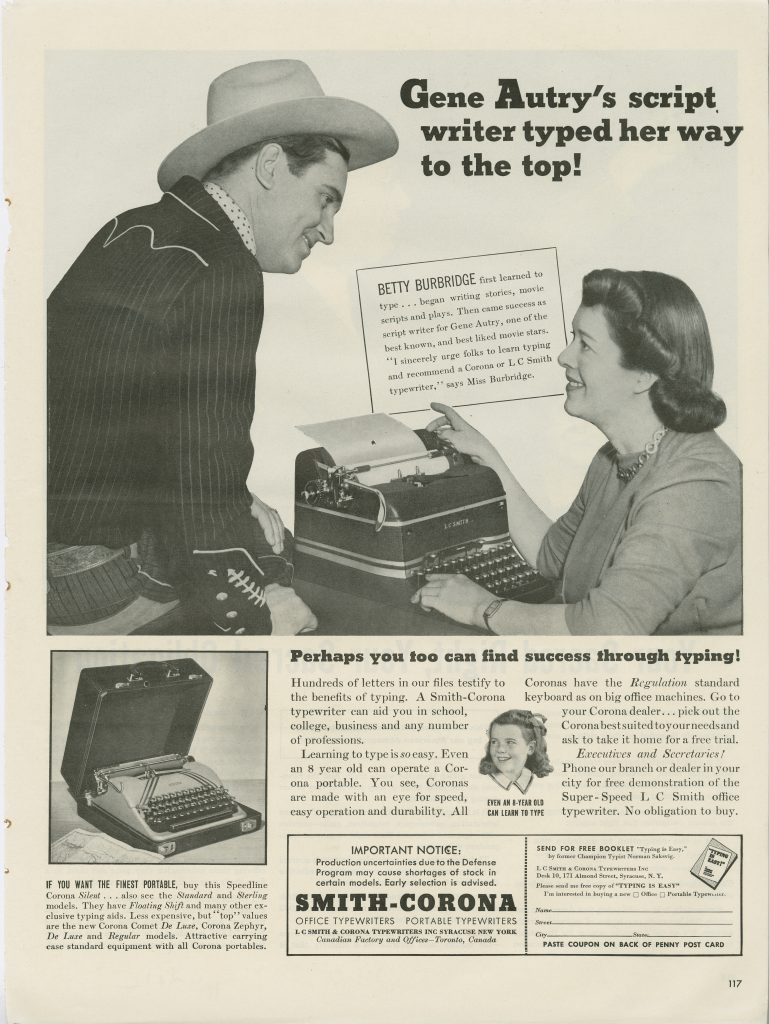
1941 advertisement in Life for Smith-Corona typewriters that features Betty Burbridge as “Gene Autry’s script writer.”
While many recognize her success within the field of screenwriting—particularly as a woman writing Westerns—they simultaneously fail to acknowledge the length of her career and the breadth of her work in the American movie industry. In fact, a 1942 article based on an interview with Burbridge suggests the writer’s career in Westerns, and film in general, only truly began in the 1930s:
Masculinity-Plus—that’s the movie cowpuncher-hero. And, of course, you reason all these good swashbuckling, hard-riding, hard-hitting yarns must be written by a man. But that’s where you’re wrong! Some of the most popular Western stories today are written by a red-headed gal who, until she began writing them, didn’t know the front from the hind-end of a saddle and had never ridden a horse in her life. Her name is Betty Burbridge and she writes stories for Gene Autry…She packs more wallop and masculinity into her Western yarns than most men and expertly captures the tone and pattern of Western screen stories […]
Who is this Western-writing gal…and how did she get that way?
Betty is the daughter of a New York newspaper woman—one of the many “Prudence Pennys.” She attended a smart finishing school and then began her writing career by editing her mother’s cooking page. She didn’t know beans about cooking but she made good. Then a family friend who was making Western pictures invited her to come to Hollywood and try her hand at writing Western scripts. Betty didn’t know beans about the West either—she’d never been farther West than Detroit and the only horse she knew by sight was the traffic cop’s. She bought herself a ticket to Hollywood and an armload of Western pulps. All the way across the continent she read Westerns. When she arrived in Hollywood she could talk of “honkey-tonks” and “bangtails.” The producer bought her first script for fifty dollars—not because he felt obliged to but because it was the best, swiftest-moving script submitted to him.
That was ten years ago [emphasis added]. Betty has been writing and selling Western scripts ever since…She spends her week-ends on a dude ranch; she can ride; and she knows all the Western lingo. (Poole 9)
In its focus on the exceptionality of Burbridge’s career in Westerns, this article reveals the general belief that the genre was a masculine one, even though several women contributed to the form in the silent and sound eras, including Adele Buffington, Bertha M. Bower, and Grace Cunard. Additionally, although Poole’s piece provides readers with the idea that Burbridge was writing before she was in Hollywood, it disregards her experience as an actress in the early industry, and upholds the notion that persists today: that what made the writer was her work with Autry.
While offering some additional details about Burbridge’s early film career, historian Lizzie Francke outlines a similar narrative in her book on women screenwriters:
[Burbridge] started her career as an actress but soon switched to journalism, becoming a syndicated columnist specializing in the traditional woman’s page subjects of home economics, etiquette and child training. From this to Westerns seems a bit of a leap, but Burbridge made the transition in the early 1930s when she was asked by a producer friend at Republic to work as a story doctor on a “cow epic.” The producer liked her ideas and hired her to work on subsequent projects. Unsurprisingly, she decided that Westerns would be more fun to write about than “cheese soufflés and chintz curtains.” (Francke 74, emphasis added)
As in Poole’s article, Francke presents Burbridge’s move into the Western genre as a dramatic shift. Here, Burbridge’s experience as actress and writer is foregrounded; however, certain important details are missing. According to a 1948 New York Times article about women who wrote Westerns, Burbridge was not a stranger to the genre in the early 1930s. As the author writes, “Betty Burbridge, whose mother was Prudence Penny, a home economics columnist for the now defunct New York American, wrote a column herself as Prudence Penny Jr. before she became an ingenue in silent Westerns under the name of Elizabeth Burbridge” (Colton). While this article recognizes her long relationship to the Western genre that I found in my own research, it still glosses over this early period and fails to acknowledge her potential career agency.
In fact, Burbridge’s early work as an actress and screenwriter during the silent era set the stage, so to speak, for her career as a Western screenwriter during Hollywood’s studio era. Not unlike many screenwriters in early Hollywood, she began her career as an actress in the 1910s. She worked with the Biograph Company, Thomas Ince, and the Essanay Film Manufacturing Company, among others. According to fellow B-Western writer C. Jack Lewis, Burbridge acted in eight films over the span of two years before she moved on to writing (173). However, the trade press and other sources credit her for over several dozen roles in other films between 1913 and 1916. For the most part, she was well received as an actress, referred to as “little,” or “dainty,” Elizabeth Burbridge in some cases (Melbourne 11; “The White Alley”). Fan magazines often listed her alongside popular stars like Cunard, Mae Marsh, Norma Talmadge, and Helen Holmes (Coward 131); and she often received positive reviews in the trade press. For example, a writer for Reel Life noted that, “Elizabeth Burbridge, leading woman of the New York Motion Picture studios, has been coming rapidly forward in her art during the last few weeks. As Ella Wheeler in the ‘Shorty’ series, she has done some remarkably clever Western character work” (“Real Tales” [1914]). During her acting days, Burbridge worked on numerous Westerns, often with Ince, and established herself as capable of depicting the “Western character,” or what Reel Life, at different times, described as presenting “a vivacious heroine, with a great deal of the ‘snap and go’ quality,” with a tendency to “rarely [betray] timidity, no matter what dangerous stunt she may be asked to do” (“Real Tales” [1914]; “Real Tales” [1915]). The list of her films featuring this type of character includes, according to the trade press, Richard V. Spencer and Ince’s The Fires of Ambition, Ince and C. Gardner Sullivan’s One of the Discard, and The Word of His People, all from 1914, and Ince and Sullivan’s “Shorty” series mentioned above. One could argue then that these acting experiences influenced Burbridge’s later status as “typical of the women [writers] who ended up in the B-Western stable” (Francke 74).
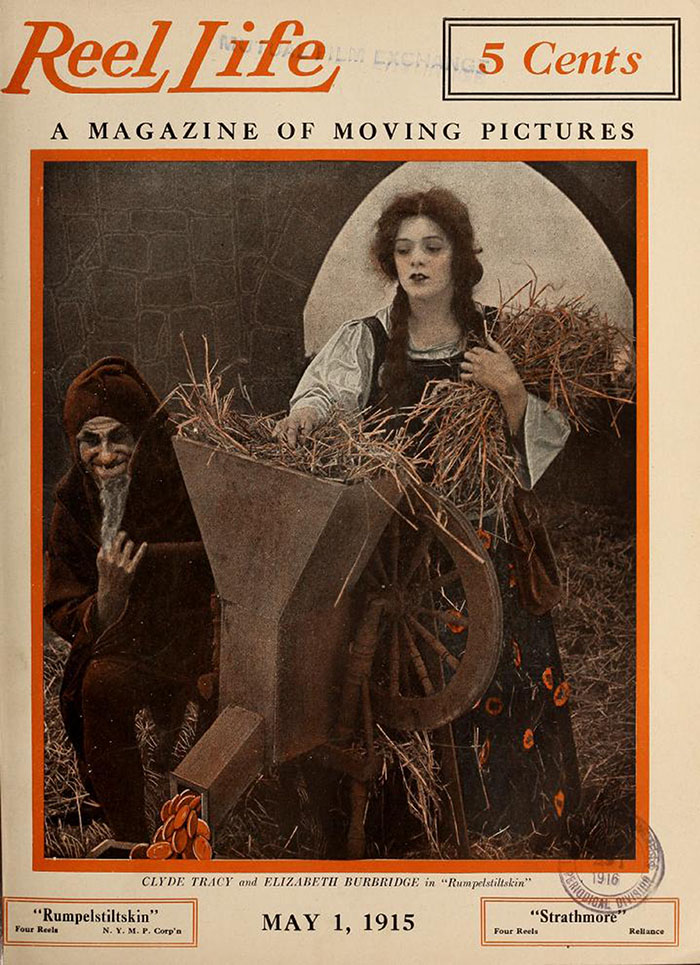
Betty Burbridge in Raymond B. West’s Rumpelstiltskin (1915) pictured on the cover of Reel Life (May 1, 1915).
While it can prove difficult to accurately track Burbridge’s film writing credits released before the emergence of the Writers Guild of America in 1933 and the implementation of more systematized accreditation and archiving—the Writers Guild Foundation only has records of Burbridge’s credits from the mid-1930s to the mid-1950s and Francke’s filmography for her only lists work from 1931 to 1949—credits listed in the trade press and multiple, international film collections and databases suggest that Burbridge did more than write for “traditional woman’s page subjects” between the time that she was acting and when she became a full-time writer in the 1930s. In 1916, The Moving Picture World wrote of Burbridge: “In addition to her activities before the camera Miss Burbridge has written and, more important, seen produced several scenarios” (“Elizabeth Burbridge with Powell”). In 1917, three years after she is said to have started acting for the screen, the trade press began to credit Burbridge as a writer of film stories. For instance, Moving Picture World reported her work on Captain Kiddo (1917) and The Film Daily and Motion Picture News her work on Milady o’ the Beanstalk (1918) (“Second Series”; “Baby Marie”; “Pathe Names Eight”).
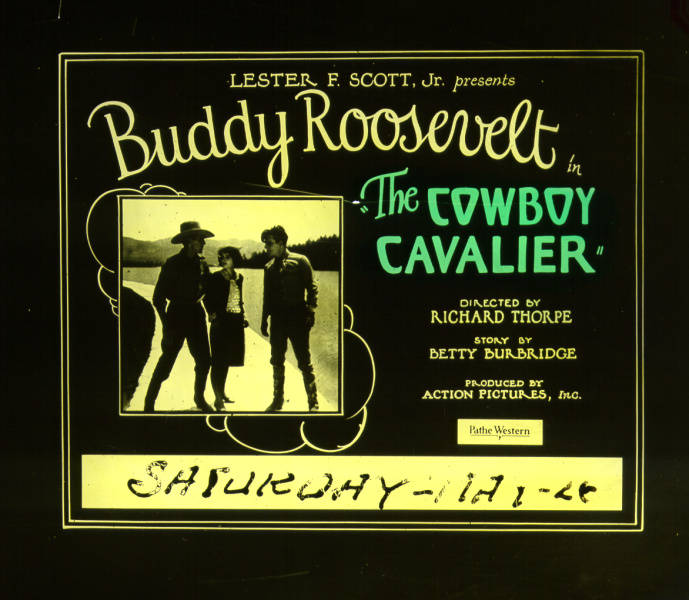
Lantern slide, The Cowboy Cavalier (1928). Courtesy of the Cleveland Public Library Digital Gallery, W. Ward Marsh collection.
Although there appears to be a gap between 1918 and 1922 when the trade press was not reporting Burbridge’s work in Hollywood, in the mid-1920s sources began regularly crediting her for work on stories and scenarios. For example, The Film Daily credited her with the story and scenario for Battling Buddy (1924), Exhibitor’s Trade Review with the story for Rough Ridin’ (1924), and Exhibitor’s Herald with the scenario for Reckless Courage (1925) (as Betty Burbridge) (“Battling Buddy”; Cruikshank; “New Pictures”). In the case of Battling Buddy, The Film Daily stated of the story: “Western comedy-drama. ‘Battling Buddy’ certainly runs away with itself toward the last couple of reels. The action gets wilder and wilder and reaches its greatest heights when Buddy [Roosevelt], on horseback, takes a nose dive off a cliff and lands right in the burning cabin in time to save the girl” (“Battling Buddy”). And although Burbridge wrote dramas, comedies, and action adventure films—sometimes even hybrids of these—her action-adventure films, like Tearin’ Into Trouble (1927), were often described as fitting a certain story pattern:
“Tearin’ Into Trouble” contains one of the popular formula type western stories wherein the hero is suspected of pulling off all the crimes in the west and even the girl believes him guilty. Wally [Wales] manages to evade capture and thus provides five reels of good action until he is ready to pull off the mask and disclose his true identity…Good action is derived from the pursuit in which the posse hits the trail. (“Wally Wales”)
Such evidence suggests Burbridge was, in fact, known to work on less-than “feminine” subjects before the early 1930s.
As an actress, and in her early years as a scenario writer, Burbridge was credited as Elizabeth, but around 1925 her credits began to read as Betty Burbridge. One can argue this switch in professional name coincided with a switch in professional capacity, from actress and storywriter to full-blown scenario and continuity writer. Very generally, this move from actress to writer was not uncommon for women in Hollywood at this time; in fact, it “was considered a good career move,” allowing them longevity in the industry after their onscreen appeal faded (Francke 12). In Burbridge’s case, she moved rather quickly from story writer to scenario and continuity writer, laying the groundwork for a career that lasted into the early-1950s. Although definitions vary, both scenarios and continuity scripts take into account much more than story. Janet Staiger claims scenario scripts are more focused on shooting order and arrangement than a story from which a film is shot (126); and Kevin Brownlow describes the scenario script as “the sequence of scenes, the story told in visual terms…From this scenario was written the continuity, or ‘shooting script,’ as it is known today” (270-272). In this sense, the scenario writer was less a storyteller than a translator, making a story comprehensible to those who make films. The continuity script, in comparison, was more about the production process and the creation of scenes. A practice that came about in the early to mid-1910s when a more complex and specialized “central producer system” of production required a more detailed script (Staiger 138), the scenario became an industry standard and “scenario writing was regarded as a more specialized and ‘professional’ craft,” by the early 1920s (Francke 18). As Francke says of Burbridge, “she proved to be dependable at her swiftly learnt craft, adhering to the formula and notching up during her career nearly a hundred film credits” (75). Moving quickly from story writer to scenario/continuity/screenplay writer, Burbridge therefore became more immersed in the movie-making process, gaining success as a screenwriter on her own merit as the industry itself grew more organized along the lines of big business.
Given her career trajectory, one can imagine that Burbridge fell into writing for B-Westerns less through default than through previous experience, both in the film industry and out. C. Jack Lewis also numbers Burbridge’s total writing credits at around one hundred, and states that seventy-seven of them were for Westerns alone (173). Burbridge may not have been born a “Western” gal—as Poole’s article points out—but her success was certainly not coincidental. As I have already shown, Burbridge not only starred in early Westerns, but many of her first writing credits were for action-adventure and Western films for companies like Action Pictures, Inc. and for early Western series stars like Buddy Roosevelt and Buffalo Bill Jr. These films often received positive feedback in the press. Presumably, then, Burbridge had gained quite a bit of experience, both as a writer and a figure in the Western production arena, before the 1930s Westerns for which she is continually credited.
Burbridge did establish a formula for writing Westerns that fit Autry’s 1930s style; but it also fit that of earlier silent Westerns—the 1927 Film Daily review of Tearin’ Into Trouble featured above certainly recognized as much. In 1939, in a New York World Telegraph article titled “She Writes Westerns for Films,” Burbridge said:
I read pulp Westerns until I was bored to tears. But that’s how I learned the story racket–that and talking to the movie cowboys on the set. When I began doing these things I’d take my plots from New York stage plays that I had seen. I’d simply change the setting to the wide-open spaces, put the characters on horses, work in a couple of chases with a sheriff and a posse–and there would be a screen story. (qtd. in Francke 75)
Here, Burbridge suggests that not only did pulp Westerns—a source previously recognized as important for her education in the genre—bore her, but most of what she learned, she learned on the set, on the fly. It is a story similar to that in other sources. Yet no specific time frame is given here. The formulaic nature of what she describes, and which Francke recognized, could just as easily have been established during the silent and serial Western period of early American cinema as it could have been well honed during the 1930s B-Westerns. In her 1942 interview with Poole, Burbridge outlined a handful of features particular to her Westerns:
“The hero must never smoke or drink—and tobacco chewing is out!…no intoxicants”; “The hero may go into a saloon to rescue someone, to consult someone, to meet someone or to beat up someone—but not to drink”; “The hero never kisses the girl if he can help it but he always wins her in the end”; “Keep gunplay at a minimum, and let the hero outwit the heavies rather than mow them down with a blitzkrieg of lead”; “If the villain must die…let it be accidentally.” (9)
These may be familiar traits of the genre for anyone who has seen numerous silent and B-Westerns; and they would have easily transferred from one era to the next as Burbridge moved from the silent to the sound period.
One reason that Burbridge’s early cinematic contributions are given little attention may be that many of her films are no longer extant—at least as far as we know now. Additionally, information on Burbridge’s career, as well as her personal life, is full of inconsistencies. Sources even appear to be torn about her actual birthdate—some, such as Western aficionado Boyd Magers, claim Burbridge was born on December 7, 1895 (44), but Filmland Favorites states she was “[b]orn in San Francisco” on December 12, 1894 (47). While you can find Burbridge’s name in the contemporary trade press for being a writer of numerous films, and you can track her contributions there and in catalogs like the AFI’s—even these sources often miss numerous credits in their reports—not much beyond this can be found regarding her career in early American cinema. Few academic sources focus on Burbridge’s work, and although there is one archive—the American Heritage Center in Laramie, Wyoming—that holds material dated from 1918-1938, providing details of at least part of her early career, I have yet to find any other collections with more evidence. Nor have I, at the time of this writing, successfully identified any relations who can share memories of Burbridge or her career. All of this makes concrete knowledge of her early contributions even more unlikely than other historical subjects. For instance, any jobs for which she went uncredited during this time will most certainly be difficult to track without further information about the writer. Interestingly, IMDb claims that Burbridge also wrote under the names of Barr Cross, Bessie Burbridge, and Robert Bridgewood, but I have found no evidence of this in the rest of my research. However, if this is the case, then the list of early contributions, both credited and uncredited, made by Burbridge may be longer than the research here suggests. With the discovery of more historical evidence we may one day get closer to the full picture of Burbridge’s role in early Hollywood history. That said, the material I have found does point to the fact that she was an important player in early as well as studio-era Hollywood, particularly in the realm of B-Westerns, in which she was already well established as a writer before she began working for the renowned cowboy and media mogul, Gene Autry.
See also: “Shaping the Craft of Screenwriting: Women Screen Writers in Silent Era Hollywood”

